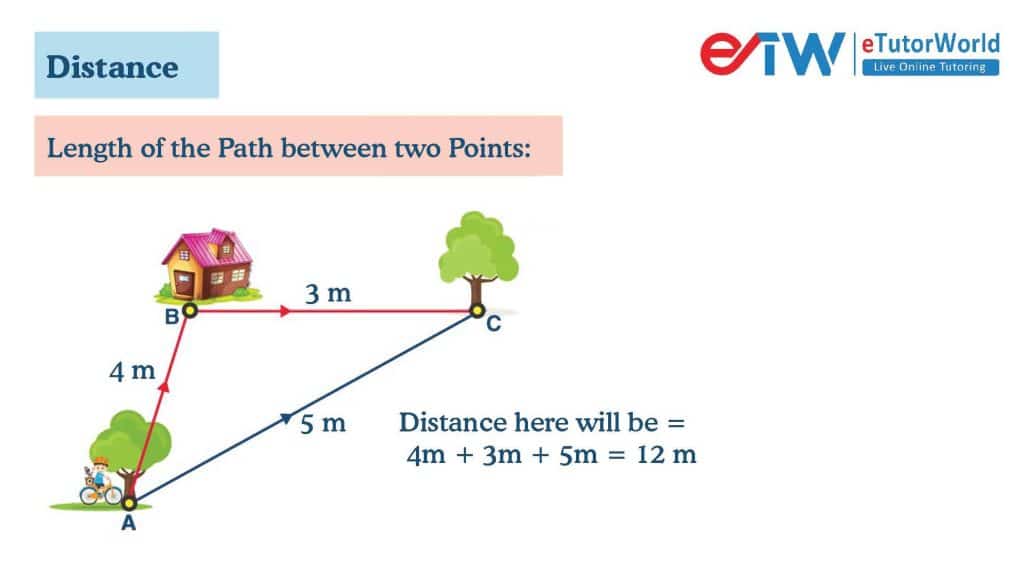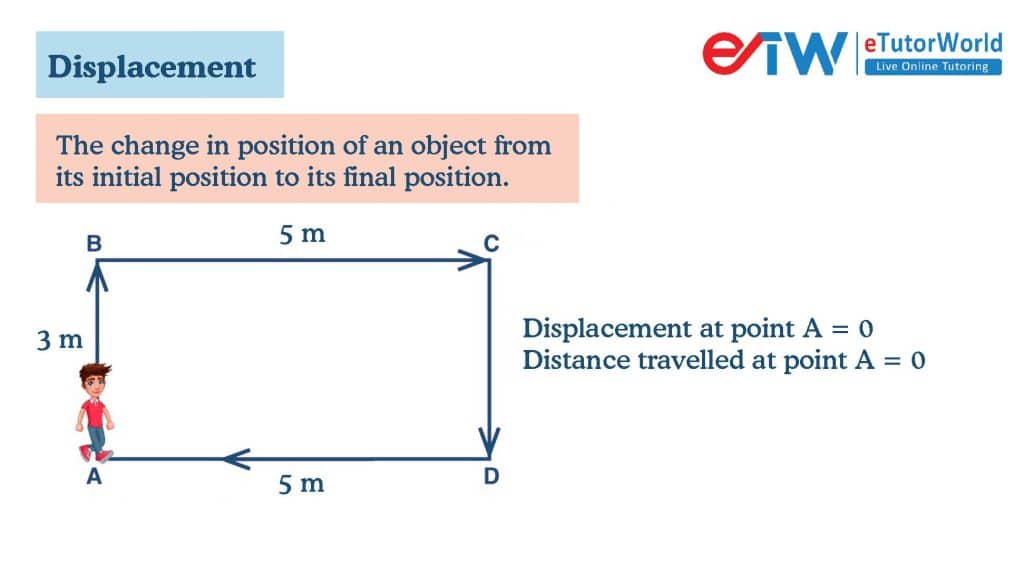Distance and Displacement
Grade 9 Science Worksheets
Distance is a scalar quantity that represents the total length of the path traveled by an object, without regard to the direction of travel. Displacement, on the other hand, is a vector quantity that represents the change in the position of an object from its initial position to its final position, taking into account both the magnitude and direction of the change.
Table of Contents:
- Distance
- Formula of Distance
- Displacement
- Formula of Displacement
- Relationship between Distance & Displacement
- FAQs
Distance and Displacement - Grade 9 Science Worksheet PDF
This is a free printable / downloadable PDF worksheet with practice problems and answers. You can also work on it online.
|
|
Untimed |
|
Sign up with your email ID to access this free worksheet.
"We really love eTutorWorld!"
"We really love etutorworld!. Anand S and Pooja are excellent teachers and are quick to respond with requests to tutor on any math topic!" - Kieran Y (via TrustSpot.io)
"My daughter gets distracted easily"
"My daughter gets distracted very easily and Ms. Medini and other teachers were patient with her and redirected her back to the courses.
With the help of Etutorworld, my daughter has been now selected in the Gifted and Talented Program for the school district"
- Nivea Sharma (via TrustSpot.io)
Distance
Distance is a scalar quantity that describes the length of the path between two points, without regard to the direction of travel. It is typically measured in units such as meters, kilometers, feet, or miles.
Here are some examples of distance:
- The distance between two cities: The distance between New York City and Los Angeles is approximately 2,800 miles.
- The distance traveled by a car: If a car travels 100 kilometers in one hour, it has traveled a distance of 100 kilometers.
- The distance between two points on a map: If two cities are located 500 kilometers apart on a map, that is the distance between them.
- The distance between two planets: The distance between Earth and Mars varies depending on their positions in their respective orbits, but can range from 34 million miles to 249 million miles.
- The distance between two people: If two people are standing 10 meters apart from each other, that is the distance between them.
In each of these examples, distance is a scalar quantity that describes the length of the path between two points, without regard to the direction of travel.

Formula of Distance
The formula for distance can be written as:
distance = |final position – initial position|
where “|” represents the absolute value, “final position” represents the position of the object at the end of the journey, and “initial position” represents the position of the object at the start of the journey.
This formula applies to one-dimensional motion, where the object moves only along a straight line. For more complex motion in two or three dimensions, the distance formula can be adapted to include the vector components of the motion.
In general, the distance formula represents the total length of the path traveled by an object, without regard to the direction of travel.
Displacement
Displacement is a vector quantity that describes the change in position of an object from its initial position to its final position, taking into account both the magnitude and direction of the change. It is typically measured in units such as meters, kilometers, feet, or miles.
Here are some examples of displacement:
- A person walking from one end of a room to the other: If a person walks 10 meters from the west end of a room to the east end, their displacement is 10 meters east.
- A car driving from one city to another: If a car drives 100 kilometers from city A to city B, its displacement is 100 kilometers in the direction from A to B.
- An airplane flying from one airport to another: If an airplane flies 500 miles from airport X to airport Y, its displacement is 500 miles in the direction from X to Y.
- A swimmer swimming across a pool: If a swimmer swims 25 meters across a pool, their displacement is 25 meters in the direction of their swim.
- A person moving up and down on a swing: If a person moves 2 meters up and then 2 meters down on a swing, their displacement is 0 meters because they have returned to their initial position.
In each of these examples, displacement is a vector quantity that describes the change in the position of an object from its initial position to its final position, taking into account both the magnitude and direction of the change.

Formula of Displacement
The formula for displacement can be written as:
displacement = final position – initial position
where “final position” represents the position of the object at the end of the journey, and “initial position” represents the position of the object at the start of the journey.
Displacement is a vector quantity, which means it has both magnitude and direction. Therefore, displacement can be positive or negative, depending on the direction of the motion.
If an object moves to the right or in a positive direction, its displacement is positive, and if it moves to the left or in a negative direction, its displacement is negative.
For example, if an object starts at position 2 meters and moves to position 8 meters to the right, then its displacement is:
displacement = 8 meters – 2 meters = 6 meters to the right
On the other hand, if the same object moves to a position 4 meters to the left, then its displacement is:
displacement = 4 meters – 2 meters = -2 meters to the left
In this case, the displacement is negative because the object has moved to the left or in a negative direction from its initial position.
“There have been times when we booked them last minute, but the teachers have been extremely well-prepared and the help desk at etutorworld is very prompt.
Our kid is doing much better with a higher score.”
9th Grade Tutoring
eTutorWorld offers Personalized Online Tutoring for Math, Science, English, and Standardised Tests.
Our Tutoring Packs start at just under $21 per hour, and come with a moneyback guarantee.
Schedule a FREE Trial Session, and experience quality tutoring for yourself. (No credit card required.)
Relationship Between Distance & Displacement
Displacement and distance are both measures of how far an object has traveled, but they are different concepts in physics.
Distance is a scalar quantity that represents the total length of the path traveled by an object, without regard to the direction of travel. Distance is always a positive value or zero, because it represents the total length of the path.
Displacement, on the other hand, is a vector quantity that represents the change in position of an object from its initial position to its final position, taking into account both the magnitude and direction of the change. Displacement can be positive, negative, or zero, depending on the direction of the motion.
In general, the displacement of an object is less than or equal to the distance it travels. This is because displacement only takes into account the change in position of the object, while distance takes into account the total length of the path traveled by the object.
For example, consider a person walking in a square path that is 10 meters long on each side. If the person walks around the square and returns to their starting point, then their displacement is zero, because they have returned to their initial position. However, their distance is 40 meters, because they have walked a total of 10 meters on each side of the square.
In another example, if an object moves forward and then moves backward to its initial position, its displacement is zero, but its distance is positive, because it has traveled a positive distance in one direction and then a positive distance in the opposite direction.
Therefore, displacement and distance are related, but they represent different physical quantities and can have different values depending on the motion of the object.
Do You Stack Up Against the Best?
If you have 30 minutes, try our free diagnostics test and assess your skills.
Distance and Displacement FAQS
What is the difference between distance and displacement?
Distance is a scalar quantity that represents the total length of the path traveled by an object, without regard to the direction of travel. Displacement, on the other hand, is a vector quantity that represents the change in position of an object from its initial position to its final position, taking into account both the magnitude and direction of the change.
How are distance and displacement related?
Distance and displacement are related in that displacement is always less than or equal to the distance traveled. This is because displacement only takes into account the change in position of the object, while distance takes into account the total length of the path traveled by the object.
What are some examples of distance?
Examples of distance include the length of a race track, the distance between two cities, and the length of a hiking trail.
What are some examples of displacement?
Examples of displacement include a person walking from one end of a room to the other, a car driving from one city to another, and an airplane flying from one airport to another.
Can displacement be negative?
Yes, displacement can be negative if the object moves in the opposite direction to its initial position. In this case, the displacement is negative because the object has moved in a direction opposite to its initial position.
Can distance be negative?
No, distance is always a positive value or zero because it represents the total length of the path traveled by an object. It cannot be negative because it is a scalar quantity that does not take into account the direction of motion.

Kathleen Currence is one of the founders of eTutorWorld. Previously a middle school principal in Kansas City School District, she has an MA in Education from the University of Dayton, Ohio. She is a prolific writer, and likes to explain Science topics in student-friendly language. LinkedIn Profile
Affordable Tutoring Now Starts at Just $22.49
eTutorWorld offers affordable one-on-one live tutoring over the web for Grades K-12. We are also a leading provider of Test Prep help for Standardized Tests (SCAT, CogAT, MAP, SSAT, SAT, ACT, ISEE, and AP).
What makes eTutorWorld stand apart are: flexibility in lesson scheduling, quality of hand-picked tutors, assignment of tutors based on academic counseling and diagnostic tests of each student, and our 100% money-back guarantee.
Whether you have never tried personalized online tutoring before or are looking for better tutors and flexibility at an affordable price point, schedule a FREE TRIAL Session with us today.
*There is no purchase obligation or credit card requirement
IN THE NEWS

Our mission is to provide high quality online tutoring services, using state of the art Internet technology, to school students worldwide.
Online test prep and practice
SCAT
SSAT
ISEE
PSAT
SAT
ACT
AP Exam
Science Tutoring
Physics Tutoring
Chemistry Tutoring
Biology Tutoring
Math Tutoring
Pre-Algebra Tutoring
Algebra Tutoring
Pre Calculus Tutoring
Calculus Tutoring
Geometry Tutoring
Trigonometry Tutoring
Statistics Tutoring
Quick links
Free Worksheets
Fact sheet
Sales Partner Opportunities
Parents
Passive Fundraising
Virtual Fundraising
Our Expert Tutors
Safe and Secure Tutoring
Interactive Online Tutoring
After School Tutoring
Elementary School Tutoring
Middle School Tutoring
High School Tutoring
Home Work Help
Math Tutors New York City
Press
©2022 eTutorWorld Terms of use Privacy Policy Site by Little Red Bird
©2022 eTutorWorld
Terms of use
Privacy Policy
Site by Little Red Bird










